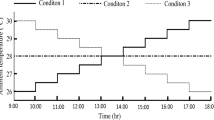Summary
Forty-two women and 18 men of mean age 54 years had their sub-lingual oral temperature measured hourly from 0700 h to 2300 h. Mean oral temperature (averaged over the 17 readings) was inversely correlated with body mass in the group as a whole (r=−0.44,df=58,p=0.0003). The women had significantly higher mean oral temperatures than the men, but the inverse relationship between mean oral temperature and body mass was still significant when the data from the women were analyzed separately (r=−0.37,df=40,p=0.013). The results suggest that in humans, mean body temperature is inversely related to body mass, irrespective of gender.
Similar content being viewed by others
References
Bartholomew GA (1954) Body temperature and respiratory and heart rates in the northern elephant seal. J Mammal 35:211–218
Christie MJ, McBrearty E (1977) Deep body temperature: diurnal variation, sex and personality. J Psychosom Res 21:207–211
Eriksson H, Svardsudd K, Larsson B, Welin L, Ohlson L, Wilhelmsen L (1985) Body temperature in general population samples. Acta Med Scand 217:347–352
Gilbreath JC, Ko R (1970) Sex differential for body temperature in Japanese Quail. Poultry Sci 49:34–36
Hocking PM, Gavora JS, Chambers JR, Fortin A (1985) Genetic variation in body size, composition, temperature, and feed intake in mature chickens. Poultry Sci 64:6–28
Horne JA, Coyne I (1975) Seasonal changes in the circadian variation of oral temperature during wakefulness. Experientia 11:1296–1298
Khosla T, Lowe CR (1967) Indices of obesity derived from body weight and height. Br J Prev Soc Med 21:122–128
McNab BK (1970) Body weight and the energetics of temperature regulation. J Exp Biol 53:329–348
Morrison PR, Ryser FA (1952) Weight and body temperature in mammals. Science 116:231–232
Ray C, Fay FH (1968) Influence of climate on the distribution of walruses,Odobenus rosmarus (Linnaeus). II. Evidence from physiological characteristics. Zoologica 53:19–32
Rodbard S (1950) Weight and body temperature. Science 111:465–466
Whittow GC, Hampton IFG, Matsuura DT, Ohata CA, Smith RM, Allen JF (1974) Body temperature of three species of whales. J Mammal 55:653–656
Author information
Authors and Affiliations
Rights and permissions
About this article
Cite this article
Adam, K. Human body temperature is inversely correlated with body mass. Europ. J. Appl. Physiol. 58, 471–475 (1989). https://doi.org/10.1007/BF02330699
Accepted:
Issue Date:
DOI: https://doi.org/10.1007/BF02330699




